The Government of Canada has launched the Climate Action Incentive Fund (CAIF), in support of small and medium-sized businesses in the renewable energy sector. It is a new incentive for businesses with fewer than 500 employees, who may be eligible for a refund up to $250,000 per project. 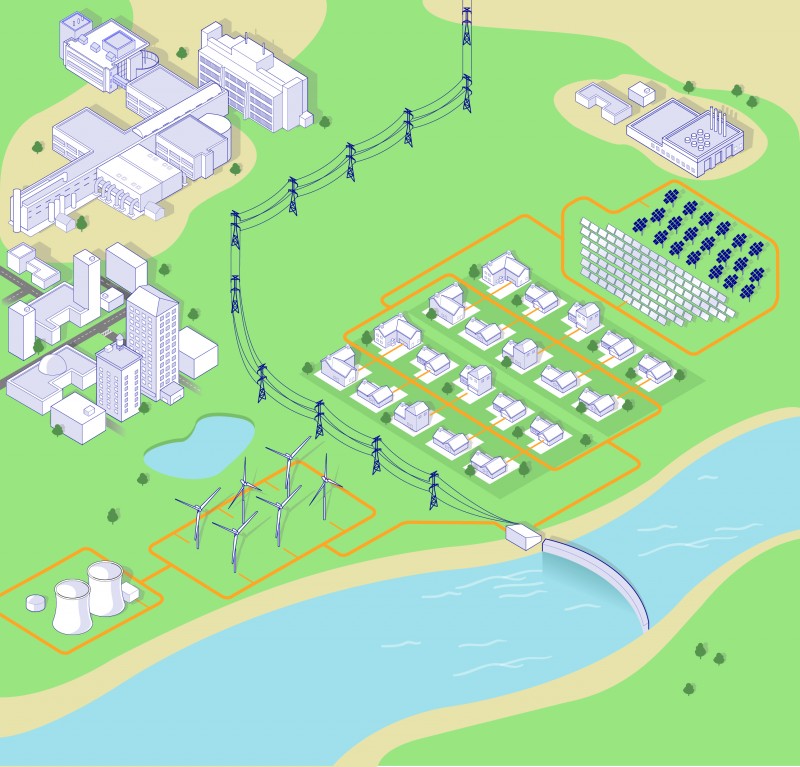
For the province of Ontario, there are $102 million funds available. The CAIF incentive will help businesses be more productive while reducing energy costs and pollution. Application is being accepted from July 17, 2019 for 90 days, or until funding exhausted.
Eligible rebate amount
Up to 25% of the project’s total eligible costs
No less than $20,000 CAD and no more than $250,000 CAD per project and per recipient
A $250,000 CAD funding cap will apply to the group of applicant franchisees who operate under the same franchise trade name in each eligible province
Eligible project categories and sample activities
Electricity, energy or fuel production
Solar photovoltaic, wind energy, micro-hydro, stand-alone storage systems that are on-site and for own-use
Combined heat and power for own use
Low-emission fuel production for own-use
District energy (heating and/or cooling)
Agricultural retrofits
Changes to agricultural processes to improve energy efficiency
Fuel switching to lower-emitting energy sources in agricultural operations
Other energy efficiency measures in the agricultural sector
Building retrofits
Enhancements to building envelope (with direct energy savings), including energy-efficient windows/doors/skylights, increased insulation, weatherproofing, and glazing
Energy-efficient lighting system
Heating, ventilation, and air conditioning (HVAC) equipment/systems/controls
Water heating retrofits, including high efficiency condensing water heating
High-efficiency motors and controls
Energy management controls, including building automation systems
Fuel switching to lower-emitting energy sources in existing buildings
Industrial process improvements
Retrofitting and upgrading of existing equipment used for industrial processes
Fuel switching to lower-emitting energy sources
Process changes
Waste-heat recovery
Transportation retrofits
Heavy-duty vehicle retrofits, including energy efficiency and/or fuel switching to lower-emitting sources
Marine vehicle retrofits, including energy efficiency and/or fuel switching to lower-emitting sources
Waste
Energy efficiency measures in waste management
Contact us, we can help you apply now to reap the benefits for your business and improve the Bottomline!
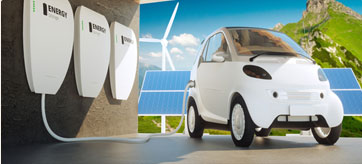
Adding a battery to your existing solar power system is not always an easy task. If your solar power system was installed storage-ready, adding the battery could be easy but with the rapid advancements of solar-plus-storage in the last few years, it is unlikely many old solar systems can easily accommodate battery connection. But that does not mean it is impossible; there are just a few important questions you must answer before starting a retrofit solar-plus-storage installation project.
What is your inverters make and model?
The inverter used on an existing solar panel system will dictate how a battery can be added to an existing solar power system. Solar-plus-storage systems are either AC-coupled or DC-coupled. AC-coupled systems require an additional, separate inverter to charge the batteries. DC-coupled systems use a charge controller to feed the power from the solar array to the batteries and then through an inverter for grid-tied use. For example, existing systems with microinverters which make the DC-AC conversion at the panel-level will need an AC-coupled system for storage, since the battery cannot be incorporated into the DC lines before AC-conversion.
To accommodate energy storage in an AC coupled system, existing grid-tie inverters must have frequency control capability. If the existing older inverters cannot frequency shift, they should be replaced to add batteries. Adding new inverter that can regulate charges is the only way to include storage on this type of existing solar PV system. Inverters are usually warrantied to 5 /10 years. If the inverter is approaching its warrantied lifespan, it’s a good idea to upgrade. It may be advantageous to replace the inverter with an inverter designed to accommodate storage to enable options to integrate storage immediately or in the future.
Why do you want to add storage?
Another question to answer – is your storage solution for emergency power? Or to store excess energy produced by solar during the day, so that it can be used in the evening when the sun goes down? Or in places with a TOU tariff, charge the batteries with solar or grid power when rates are cheap and discharge the batteries when power is most expensive. Depending on your objective, it is important to have an inverter that allows for your specific storage need and an appropriately sized battery bank to support your power needs.
Who owns the solar system?
Another question to answer – is your existing solar PV system owned by you or leased? If you have full ownership adding storage is easy. If your existing solar panel system leased it may have restrictions on adding certain equipment. Typically leased solar power systems have a wide range of restrictions as to what changes can be made to the home or business and its electrical loads. Adding energy storage may be prohibited by lease terms.
If you are thinking of adding energy storage to your existing solar PV system and much it would cost to have peace of mind with a solar plus battery power system complete the Free solar Assessment request at our website or give us a call at 416-855-9377.
We are one of the top solar energy companies providing solutions that are second to none. We provide solar plus storage hybrid energy solutions across Ontario including Toronto, Markham, Mississauga, Burlington, Oakville, Brampton, Vaughan, Ajax, Pickering, Whitby, Oshawa, Caledon, Stouffville, Richmond Hill, Newmarket, Aurora, Milton, Georgetown, and the Greater Toronto Area (GTA).
As the power outages and utility rates increase, it becomes necessary for businesses and homeowners to have a backup system to meet these emergencies.

Currently, many who need backup opt for a generator to meet their needs created by the unexpected power outages. But a generator introduces many expenses and undesirable environment.
With generator backup, many suffer badly from the noise and smelly gases exhausted by the generators. Exhausted gases are not only smelly but also harmful to the environment and create health hazards. Generators also need to be operated monthly basis even when there is no power outage to ensure their proper operation and serviced by a generator company approved service person to maintain the generator warranty.
With the reduction in solar and storage prices solar battery storage energy systems are becoming popular as backup power systems for providing electricity for many applications.

With solar battery backup system, the excess energy generated by solar during daylight hours can either be stored in the batteries for later use or sold back to the grid. Both the grid and the solar array can charge the battery of a solar battery power system.
A generator backup is used only when there is a power outage, in contrast, a solar battery backup power system is used on a daily basis for smart energy management. Solar battery power system allows the user to choose how much solar generation goes into the battery and how much goes back to the grid as well as at what time it is sold back.
The utility rates are different depending on the time of day which means that energy can be bought from the grid during low-cost hours stored in the battery and used during high-cost hours. Unlike generators, solar battery power system does all these without making any noise or releasing any harmful gases. Many of our customers are thrilled with how well the system performs and how quite their house compare to running a generator.
If you are wondering how much a solar installation would cost to offset the electricity bill, and have peace of mind with a solar battery power system complete the Free solar Assessment request at our website e or give us a call at 416-855-9377. We are one of the top solar energy companies providing solutions that are second to none. We provide solar plus storage hybrid energy solutions across Ontario including Toronto, Markham, Mississauga, Burlington, Oakville, Brampton, Vaughan, Ajax, Pickering, Whitby, Oshawa, Caledon, Stouffville, Richmond Hill, Newmarket, Aurora, Milton, Georgetown, and the Greater Toronto Area (GTA).
A hybrid energy system usually consists of two or more energy sources used together to provide increased system efficiency as well as greater availability of energy supply. The intensity of solar radiation and wind can change randomly, and electricity generated from these resources will also change randomly without any notice. With the increased amount of power generation from solar and wind, energy storage is becoming increasingly important for reasons including the availability of power, grid stability, energy management as well as demand reduction.
 There are many different energy storage technologies – mechanical, pumped storage, thermal – molten salt, and chemical-batteries. Each type of storage has unique characteristics that differentiate them from others, as well as the types of power sources with which they can be integrated.
There are many different energy storage technologies – mechanical, pumped storage, thermal – molten salt, and chemical-batteries. Each type of storage has unique characteristics that differentiate them from others, as well as the types of power sources with which they can be integrated.
Chemical storage systems are generally battery-based systems that use chemical reactions to store and convert energy. Battery-based storage systems had been widely in use in many small to midsize day to day applications. Now Lithium ion batteries based storage systems have become the choice for large scale day to day applications.
With regularly rising and tiered utility rates more and more people are choosing to invest in hybrid solar energy systems which provide them with both stable power and energy savings. In areas where the utility grids are not stable, hybrid solar energy systems are the ideal solution currently on the market. Acting as a backup when the grid is down, and allowing owners to send excess power back to the grid when there is excess energy.
With a solar hybrid system with battery backup, the excess energy generated during daylight hours can either stored in the batteries for later use or send back to the grid. Hybrid inverters have smart electronics on board that allow the user to choose how much solar generation goes into the battery and how much goes back to the grid as well as at what times. Smart hybrid inverters also enable the customers to buy from the grid during low-cost hours and send back to the grid during high-cost hours. Solar alone cannot do this; the battery in the hybrid system is what makes this possible to do all these.
In the case of the hybrid solar PV system, both the grid and the solar array can charge the battery. The hybrid inverter allows the user to choose how much of either one will flow into the battery. Some hybrid inverter systems can connect to 3 different power sources, the grid, the solar array, and a generator. They are each controlled by the hybrid inverter and are utilized based on the user’s settings during commissioning.
We are one of the top solar energy companies providing solutions that are second to none. We provide solar plus storage hybrid energy solutions across Ontario including Toronto, Markham, Mississauga, Burlington, Oakville, Brampton, Vaughan, Ajax, Pickering, Whitby, Oshawa, Caledon, Stouffville, Richmond Hill, Newmarket, Aurora, Milton, Georgetown, and the Greater Toronto Area (GTA).
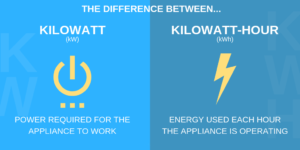 People looking for solar options often puzzled with terms kilowatt and kilowatt-hours. Electricity used is measured by kilowatt hour and the solar power systems are sized in kilowatts. This is where questions often come about kilowatts and kilowatt-hours.
People looking for solar options often puzzled with terms kilowatt and kilowatt-hours. Electricity used is measured by kilowatt hour and the solar power systems are sized in kilowatts. This is where questions often come about kilowatts and kilowatt-hours.
So what exactly does a kWh mean and how does it differ from a kilowatt (kW)?
A kilowatt is a measure of how much power (capacity) a device can provide; kilowatt-hours define the amount of work performed in one hour of time or amount of energy used to do that work. A 1.5 kilowatt (1500 W capacity) kettle will boil the same amount of water faster than a 1 kilowatt (1000 watt capacity) kettle. Regardless of the power of the kettles, energy needed to boil the same amount of water is the same. In this case, energy is provided by electricity and the amount of electricity used by both kettles to boil the water is the same.
Energy use and kWh in context
Say 1.5 kilowatt (1.5KW) kettle took 0.5 hours (30 minutes) to boil the water, electricity used = 1.5 X 0.5 = 0.75 kwhr; unit of measure for electricity (energy) is kwhr. We know smaller kettle takes longer to boil the water; how long? We know electricity (energy) used by both kettles are the same; 1 X T = 0.75, T = 0.75 hours (45 minutes), 1-kilowatt kettle will take 45 minutes to boil the same amount of water.
Why kWh matter when you’re going solar
The Net Metering program allows offsetting the electricity purchased from the utility company with solar electricity during twelve consecutive months. To do this as solar energy solutions providers we need to size the solar power system that is able to produce the amount of electricity a customer use in twelve consecutive months. Electricity bill report usage in kwhr, and when evaluating solar installation to offset this electricity we talk about the size of the solar power system needed in kW.
In the earlier example, we talked about how a 1,000-watt kettle will use 1 kilowatt-hour in one hour of use. When talking about solar, the process of converting power capacity (watts) into expected energy output (kWh) is not as simple due to a number of factors. One thing is certain: a kettle will consume power at a constant rate regardless of whether or not you live in Toronto or California, if it’s raining or if it’s placed on a certain type of countertop. Whereas solar panels output is greatly affected by the environment and circumstances it is installed.
Factors such as the angle and orientation of the roof and the amount of sunlight hours in the town solar panels are located will significantly impact how much electricity it will produce. So, for example, a solar panel on the north side of a roof will produce than the same panel on the south side of the roof because south facing roofs typically receive higher sunlight exposure.
Those wondering how much a solar installation would cost to offset the electricity bill, complete the Free solar Assessment request at our website e or give us a call at 416-855-9377.
We are one of the top solar energy companies providing solutions that are second to none. We provide energy solutions across Toronto, Markham, Mississauga, Burlington, Oakville, Brampton, Vaughan, Ajax, Pickering, Whitby, Oshawa, Caledon, Stouffville, Richmond Hill, Newmarket, Aurora, Milton, Georgetown, and the Greater Toronto Area (GTA).
Lithium-ion battery cost has fallen since 2010 and it highly benefits the electric vehicle and renewable energy storage markets. Although Lithium-ion battery costs have fallen considerably, they are still not affordable for many home and business owners. Even if lithium-ion solar battery cost doesn’t fit in your current budget, planning for a solar system with energy storage will be a good idea for the future and save your money in the long run.
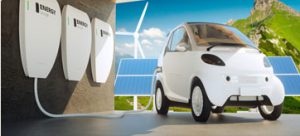 Why Install Batteries?
Why Install Batteries?
Grid-tied systems are required to shut down during blackouts, even when the sun is shining. This is a regulated safety design feature of grid-tied solar energy systems intended to prevent workers from getting electrocuted while performing repair work on power lines. Unless solar PV system has battery storage, solar system owners cannot use the solar power from the grid-tied solar PV system during power outages.
Installing batteries also enables the use of solar energy when the sun isn’t shining-night and cloudy days. Some utilities also charge higher rates during peak hours and for peak power consumption. Installing batteries allow customers to use stored solar energy instead of more costly grid power during peak hours and reduce peak power consumption. This option is becoming very popular in Hawaii and California, where cost of electricity associated with peak hours is very high.
If you are in the process of installing a solar panel system and want the option of battery storage in the future, it will be helpful to plan accordingly. If the solar system is designed considering storage option in mind, it will be relatively easy to add the batteries to the system in the future.
It is more difficult and more costly to add battery storage in the future if the solar system is not battery ready. Choosing a solar system with an inverter that has battery storage capabilities is one way to prepare for adding batteries in the future. This would enable the solar system to operate only as a grid-tied solar panel system until batteries are added. Therefore, it will be beneficial to consult a reputable solar PV system designer to avoid unnecessary expenses in the future. New Dawn Energy Solutions will work with you to design your storage ready solar PV system.
Thinking to install solar now and add storage later? Contact us for a free consultation at info@newdawn-es.com or 416-855-9377.
 Incorporating energy storage into a solar array is not as easy as just picking a battery off the shelf. Certain chemistries work better in certain environments and storage capabilities are influenced by the solar application.
Incorporating energy storage into a solar array is not as easy as just picking a battery off the shelf. Certain chemistries work better in certain environments and storage capabilities are influenced by the solar application.
Lead-acid batteries have been popular within off-grid solar installations for decades. However lithium-ion batteries are preferred choice for solar, EV and residential applications since they have a longer life cycle, lighter weight, and decreased maintenance. In addition, a recent study in the US found that lithium-ion batteries represented more than 80% of the installed power and energy capacity of large-scale energy storage applications.
Lithium-ion batteries are not the only choice for batteries used in solar+storage installations. Here’s a brief rundown of the common storage technologies used in the renewable industry.
Lithium-ion Batteries
Lithium-based energy storage systems are overwhelmingly the most common storage technology used within the solar market. These batteries are characterized by the transfer of lithium ions between electrodes during charge and discharge reactions. Additional materials, such as cobalt, nickel, and manganese, are inserted into the battery cells and can affect the battery’s performance, voltage, and safety. Lithium-ion batteries are more expensive than other chemistries, mostly because of their need for battery management systems to monitor voltage and temperature. The benefits of lithium-ion include long life cycle, high charge, and discharge efficiency, lighter weight, no maintenance, solid and they don’t require refills.
Types Lithium-ion Batteries
There are many different types of Lithium-ion batteries. To name a few: Lithium Cobalt Oxide, Lithium Manganese Oxide, Lithium Nickel Manganese Cobalt Oxide, Lithium Nickel Cobalt Aluminum Oxide, and Lithium Iron Phosphate.
Lithium Cobalt Oxide batteries are very stable and small, making them a popular choice for cell phones and laptops. They have a higher risk of thermal runaway and fire danger, which is why often hear news of some cell phones catching fire.
Lithium Manganese Oxide batteries have fast-charging properties and increased thermal stability making them a popular choice for medical devices and power tools.
Lithium Nickel Manganese Cobalt Oxide batteries have high specific energy and stability. But their use of cobalt increases the risk of thermal runaway.
Lithium Iron Phosphate batteries have increased safety, thermal abilities, and a long lifecycle. Since they generate little heat, they can be installed in more unique, indoor applications.
Lead-acid Batteries
Lead-acid chemistry is one of the oldest forms of energy storage and is widely used. Lead-acid batteries are known for being dependable and inexpensive. Lead-acid batteries are heavy because of the materials involved. They have a limited cycle life and are inefficient when it comes to charge and discharge compared to Lithium chemistries. But they’re cheap to manufacture and reliable if it’s operated and maintained properly.
Types of Lead-acid Batteries
Flooded lead-acid batteries must be flooded with a liquid. They require significant care and maintenance. Flooded batteries need to be refilled regularly as the electrolytes evaporate during charging. These batteries must also be housed in an enclosure with enough ventilation to keep off-gassing levels from reaching a dangerous point.
Valve Regulated Lead-Acid batteries are “sealed” and use valves to regulate off-gassing. They require little to no maintenance when compared to flooded lead-acid batteries. There are two categories of Valve-Regulated Lead-Acid batteries – AGM and gel. AGM batteries perform better in colder temperatures, while gel batteries work better in warmer temperatures.
Flow Batteries
Flow batteries use two chemical components dissolved in liquids separated by a membrane to provide a charge. Flow batteries can be recharged instantly by replacing the electrolyte liquids and store additional electrolytes externally in tanks that are pumped into the system as required. Flow batteries excel in long-duration storage applications and require little maintenance.
We all know that the Ontario government’s Feed in Tariff programs had been phased out but many do not know that Ontarians can still install solar panels and connect them to the grid under Net Metering program.
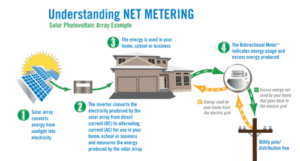 The Net Metering program provides Ontarians with the opportunity to optimize their energy usage and generate the electricity needed with solar panels on their rooftops. From start to finish, a typical Net Metering installation takes two to three months and New Dawn Energy takes care of the entire process for you from initial assessment to commissioning with skills and professionalism.
The Net Metering program provides Ontarians with the opportunity to optimize their energy usage and generate the electricity needed with solar panels on their rooftops. From start to finish, a typical Net Metering installation takes two to three months and New Dawn Energy takes care of the entire process for you from initial assessment to commissioning with skills and professionalism.
New Dawn Energy designs and installs Net Metering systems that allow you to use the electricity from the solar panels to reduce or eliminate your dependence on the utility company. The amount of electricity you can generate depends on the number of panels your roof can accommodate.
You will receive credit for your excess solar electricity production and you can use the credit when there is not enough electricity production from your solar system to get the electricity from your utility company. This means you only pay when your solar electricity credit is less than the electricity power supplied by the utility. The credit your solar power system produce can be carried forward for up to a year. This means you can create credit during summer months when your solar power system produce more electricity and use during winter months when you solar power system produce less electricity.
Net Metering program allows to integrate energy storage with your solar power system. When energy storage is integrated into your solar power system you get to use most of the electricity your solar power system produce. Energy storage system can also help to reduce peak demand thereby reducing demand charges, provide backup power for you during blackouts and help to buy electricity at lower price time for using at high price time.
New Dawn Energy’s Net Metering system is constructed with high quality durable components from tier-one manufacturers. The components we choose to use are the best in their category hence give you the ability to produce maximum electricity from your roof area and without regular maintenance requirements.
The City of Toronto offers Torontonians Home Energy Loan Program (HELP), which is a low-interest loan program to cover the cost of new rooftop solar power systems and other energy efficient technologies. In addition to low-interest rates low as 2%, repayment terms can be up to 15 years and the loan can be paid off at any time without penalty. If you sell your home and don’t want to pay off the loan, the new homeowner can assume the payments and enjoy the savings from the solar power system.
If you would like to know more about New Dawn Energy’s Net Metering solutions or energy storage solutions, or would like a free quote, contact us by clicking here and submitting the form or give us a call at 416-855-9377.

New Dawn Energy sets a new standard in clean energy by offering the highest quality pairing of solar + energy storage equipment. This solution is now available to our residential grid-tied and off-grid customers in Ontario and around the world.
New Dawn Energy focuses on quality, performance and customer satisfaction as the keys to enhance the rapid adoption of clean energy technology. New Dawn Energy has identified the best-performing solar + storage equipment to provide the best performing solar + storage systems to our customers.
New Dawn Energy’s systems are smart, safe and the battery technology is warrantied to last longer than most other energy storage systems. By combining solar + storage energy systems homeowners are able to store energy, and manage electricity usage efficiently. Most importantly, they can gain peace of mind with the ability to power their homes and communities with clean energy, even during brownouts, blackouts and extended periods of power outages.
With our high quality intelligent residential storage solution, we are confident in our ability to meet growing consumer demand for solar + storage and further adoption of sustainable technologies by homeowners in GTA and around the world. New Dawn Energy’s all-in-one turnkey energy solutions not only seamlessly integrate into modern and tech-savvy homes, but also provide power to remote area homes and communities in Canada and elsewhere.





